Apps
Auto Added by WPeMatico
Auto Added by WPeMatico
As the world continued to cope with the impact of the coronavirus outbreak, the second quarter of 2020 became the largest yet for mobile app downloads, usage and consumer spending. According to new data from app store intelligence firm App Annie, mobile app usage grew 40% year-over-year in the second quarter of 2020, even hitting an all-time high of over 200 billion hours during April. Consumer spending in apps, meanwhile, hit a record high of $27 billion in the second quarter. And app downloads reached a high of nearly 35 billion.
The growth in app usage has been fueled by social distancing and lockdown measures, as countries around the world try to quell the spread of the novel coronavirus.
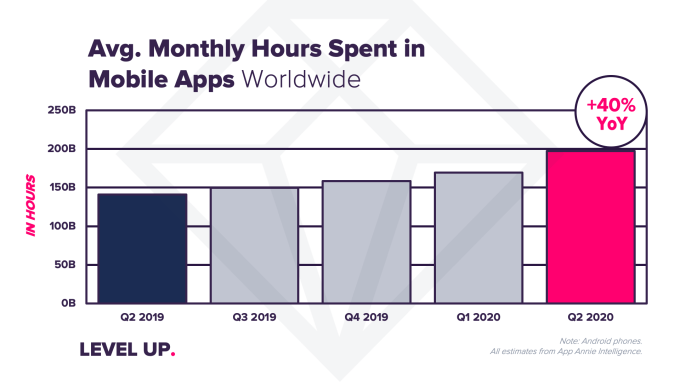
Image Credits: App Annie
In India, for example, time spent in apps grew 35% in Q2 2020 from Q4 2019. Italy and Indonesia saw growth of 30% and 25%, respectively. In the U.S., time spent in apps grew 15%.
App Annie says now the average user is spending 4 hours and 20 minutes per day on their smartphones.
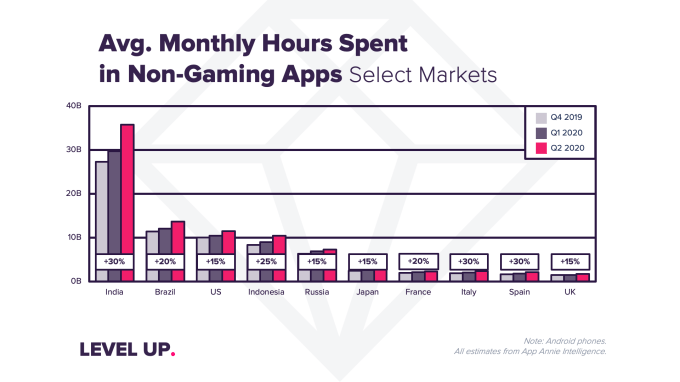
Image Credits: App Annie
But consumers aren’t just launching apps they already have installed on their phones — they’re also downloading new ones. In the second quarter, consumers downloaded nearly 35 billion new apps, an all-time high.
Google Play accounted for 25 billion of those downloads, representing 10% year-over-year growth. India and Brazil were the the two largest markets for Google Play in the quarter.
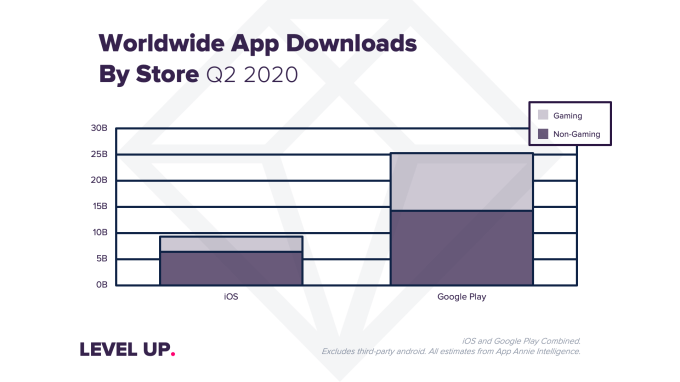
Image Credits: App Annie
iOS downloads grew 20% year-over-year to reach nearly 10 billion. The U.S. and China were iOS’s biggest markets for downloads, but the U.S. and Saudi Arabia saw the most quarter-over-quarter growth. The latter was likely attributed to a nationwide lockdown and school closures, driving app downloads in the country to a all-time high in April and 100% year-over-year growth on iOS.
Games were downloaded at record levels in the quarter, App Annie noted, totaling 14 billion games. In the first week of Q2, weekly mobile game downloads broke records at over 1.2 billion, and weekly download levels remained at 1 billion on average throughout the quarter, up 20% year-over-year.
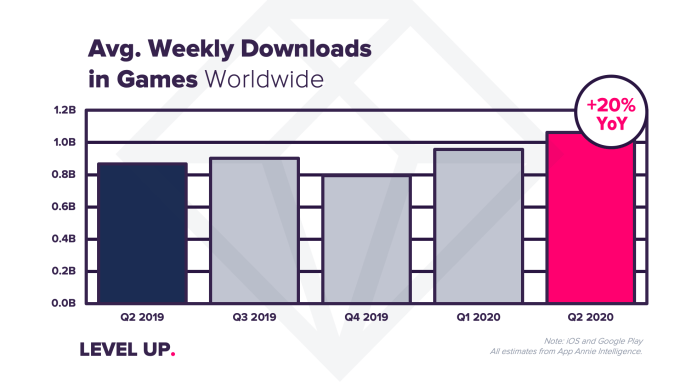
Image Credits: App Annie
Non-gaming apps represented over half (55%) of the new downloads on Android and 70% of those on iOS.
More specifically, top categories outside of games included “Tools” and “Entertainment” on Google Play and “Photo and Video” and “Entertainment” on iOS. But other categories saw strong growth, including “Business,” “Health & Fitness” and “Education,” which saw quarter-over-quarter growth in downloads of 115%, 75% and 50% respectively on Google Play.
On iOS, “Health and Fitness,” “Shopping” and “Medical” apps saw strong quarter-over-quarter growth of 30%, 25% and 20%, meanwhile.
With record downloads and usage, consumer spending also grew significantly as a result, particularly among streaming video services.
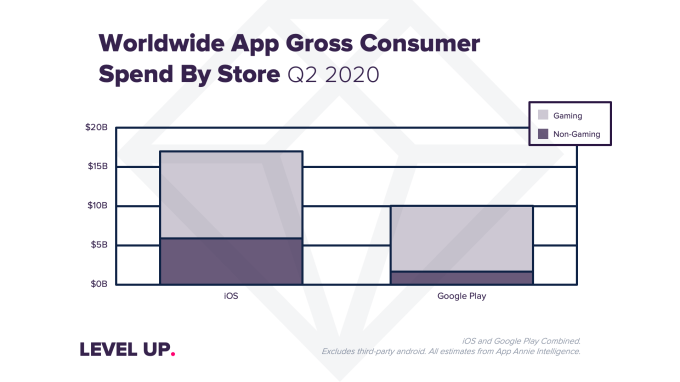
Image Credits: App Annie
In the second quarter, consumers spent a record $27 billion in apps, up 15% year-over-year to $17 billion on iOS and up 25% to $10 billion on Android.
Games accounted for $19 billion of the spend, up 15% quarter-over-quarter. Google Play saw sizable growth at 25% quarter-over-quarter, which was 2x the growth rate on iOS.
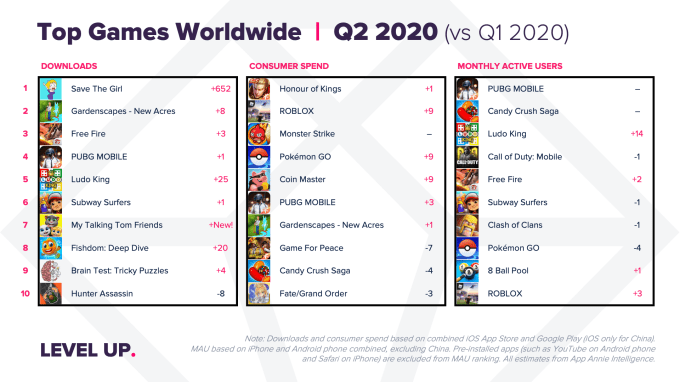
Image Credits: App Annie
Non-gaming apps were 35% of the spend on iOS. The U.S. and China the largest contributors in both games and non-game apps on iOS in the quarter. However, the U.S. notably took back the top position as the largest market for consumer games — a spot previously held by China — with 30% quarter-over-quarter growth in Q2.
Non-games were 15% of the spend on Google Play. The U.S., Japan, and South Korea were the largest markets in both non-games and games alike on Google Play.
Top Google Play categories in addition to “Games” included “Social” and “Entertainment.” Growth in the “Entertainment” category was driven largely by Disney+ and Twitch, App Annie noted.
On iOS, “Entertainment” and “Photo and Video” were the largest categories by consumer spend, in addition to “Games.” Here, TikTok drove growth for the “Photo and Video” category, becoming the No. 1 top-grossing app on iOS App Store globally in Q2 2020 thanks to sales of virtual gifts used to tip streamers.
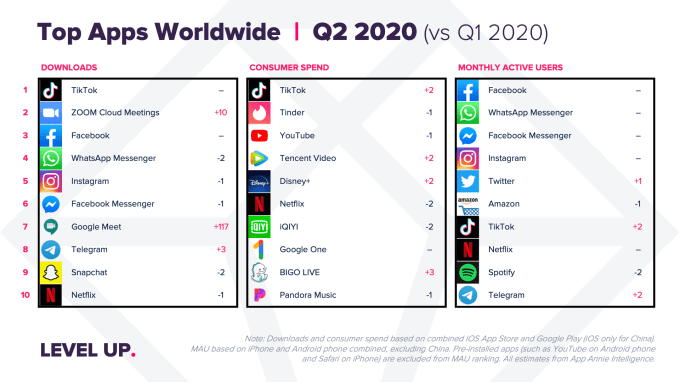
Image Credits: App Annie
While much of the activity taking place on mobile devices during the pandemic is related to having fun — like watching videos or playing games, for example — several of the top apps in the quarter were work-related.
Zoom, for instance, became the No. 2 of most downloaded app globally in Q2 2020. Google Meet was No. 7.
TikTok, meanwhile, was the top app by downloads and spending, and the No. 7 by monthly active users. That will likely change in the months ahead, due to its ban in India. A proposed U.S. ban has also recently seen TikTok rivals gaining ground. Amid this disruption, local competitors in India have seen increased usage, and elsewhere, competitors like Byte and Likee have surged.
Powered by WPeMatico
Tinder announced this morning it will begin to test video chat in its mobile dating app with some members in select worldwide markets, including in the U.S. The feature, which allows Tinder matches to go on “virtual” dates when both opt in, will first be available to users in Virginia, Illinois, Georgia and Colorado in the U.S., as well as in Brazil, Australia, Spain, Italy, France, Vietnam, Indonesia, Korea, Taiwan, Thailand, Peru and Chile, also with some members.
Parent company Match had first promised it would introduce video chat in Tinder as part of its Q1 2020 earnings report and touted the feature as a way Tinder was evolving its business in the face of the coronavirus pandemic. The company had also then detailed the pandemic’s impact on its app, which had slowed Tinder user growth in the quarter as social distancing requirements and government lockdowns went into effect.
Tinder ended Q1 with 6 million subscribers, up from 5.9 million in December 2019 — meaning it only added 100,000 paid subscribers during the quarter. For comparison, in the year-ago quarter it added 384,000 paid users. Tinder’s average revenue per user (ARPU) also grew just 2%, mainly due to purchases of à la carte features, not subscriptions.
Tinder parent Match says it had tested video at various times before the COVID-19 outbreak, but said it never saw significant adoption. The pandemic has changed things, however. Today, Tinder allows users to search for matches worldwide through its Passport feature, making its dating app more of a social network. Meanwhile, Tinder users who do want to date now feel almost forced to use video for their early interactions instead of going on briefer “getting to know you” coffee or drink dates, as before.
Without a video option in the app, these users often turned to third-party apps like Snapchat or other video chat apps for these early connections. Meanwhile, daters who prioritized a video option may have even made the switch to rival Bumble, which has offered video for a year. Facebook also recently said it would add video for its Facebook Dating users, as a result of the coronavirus pandemic, forcing Tinder’s hand.
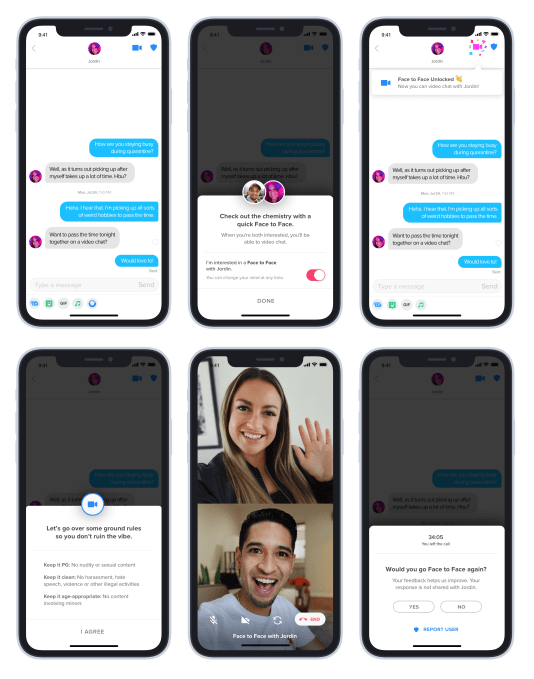
Image Credits: Tinder
The new feature itself is simple to use. Once two people have matched and are chatting in the app, they can indicate they’re ready to move to a video session by tapping the new video icon. The clever part is that the feature itself isn’t enabled until both matches opt in. The company notes that Tinder users won’t be informed if a match toggles on the video chat feature. The idea is to wait until the discussion comes up naturally, as it often does in a text-based chat.
When both users have toggled on video chat, they have to agree to ground rules before the chat begins. Tinder says calls should remain “PG,” with no nudity or sexual content. The chats are also supposed to stay “clean,” meaning no harassment, hate speech, violence or other illegal activities. Users also agree calls will need to be age-appropriate, meaning without minors involved.
The feature, which Tinder calls “Face to Face,” is enabled on a match-by-match basis, not universally for all matches.
How exactly Tinder plans to properly moderate what appears to be a fantastic new solicitation platform remains less clear. In addition, Tinder’s move to embrace video means it could be putting sex offenders in front of the camera. As an investigative report last year from ProPublica found, most of the Match-owned dating apps, including Tinder, were not screening for sexual predators.
For now, Tinder says users are asked to review the call when it wraps.
In a pop-up, users who finish a video call will be asked whether they would go Face to Face again. Here, they’ll also have the option to report the user, if needed. These sorts of retroactive rating systems don’t do much for anyone who feels unsafe in the moment, of course, and it’s not clear to what extent Tinder will step in to police calls in progress.
Asked for specifics, Tinder declined to share. (In an earlier report, Tinder CEO Elie Seidman suggested Tinder would use machine learning models to monitor chats.)
Also unclear is to what extent Tinder would step into to stop what may otherwise be consensual sexual activity, including of the paid variety.
Tinder doesn’t seem worried about these off-brand use cases for video chat, however. It says it recently surveyed around 5,000 members in the U.S. and around half of them have already had video dates with a match off its platform over the past month, indicating a willingness to try video for online dating. In addition, 40% of Gen Z members said they wanted to keep using video as an initial step before agreeing to meet in real life, even when places like restaurants and bars were re-opened.
“Connecting face-to-face is more important than ever, and our video chat feature represents a new way for people to get to know one another in-app no matter their physical distance,” said Rory Kozoll, head of Trust and Safety Products at Tinder, in a statement about the launch. “Face to Face prioritizes control to help our members feel more comfortable taking this next step in chats if and when it feels right for them. We’ve built a solid foundation, and look forward to learning from this test over the coming weeks,” Kozoll added.
The feature is launching in testing only starting today, in select markets.
Powered by WPeMatico
The much-anticipated addition of “Hamilton” seems to have paid off for Disney+. According to new data from app store analytics firm Apptopia, Disney’s streaming service saw a big jump in downloads over the July 4 holiday weekend in the U.S., following the worldwide debut of “Hamilton” on Friday, July 3rd. Between Friday and Sunday, that translated to over half a million new global downloads (752K+) for the Disney+ mobile app, excluding India and Japan. Some 458K+ of those downloads were in the U.S, the firm estimated.
These figures represent a 46.6% increase over the average seen during the previous four weekends in June (Friday through Sunday), Apptopia noted. But the numbers don’t include India or Japan as Disney+ is streamed via Hotstar in the former; and in the latter via a partnership with NTT Docomo through an existing service that later transitioned to Disney+.
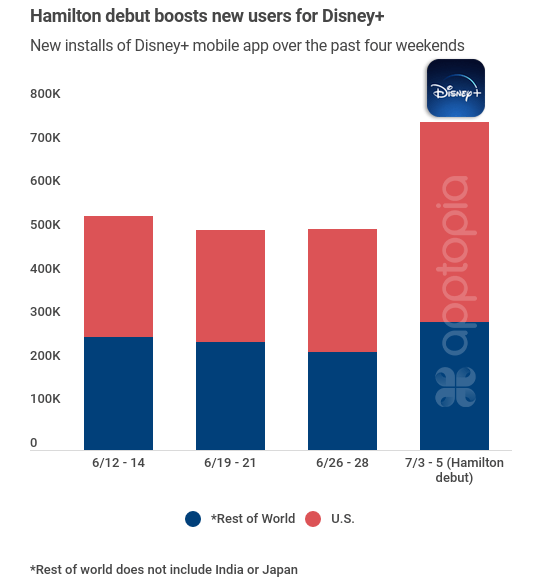
Image Credits: Apptopia
The download figures also represented a 74% increase over the four prior weekends in June, in the U.S, indicating that a significant amount of interest in “Hamilton,” not surprisingly — given its “founding fathers” subject matter — comes from U.S. subscribers.
Notably, these downloads represent paid subscribers, not free trial users, as Disney+ ended its free week-long trial offering back in June.
Rival firm Sensor Tower estimates a slightly different “Hamilton”-related bump for Disney+. During the week of June 29 to July 5, downloads spiked 64% over the week prior, Yahoo reported. Its preliminary estimates for July 3-5 put installs at 1 million across all available markets.
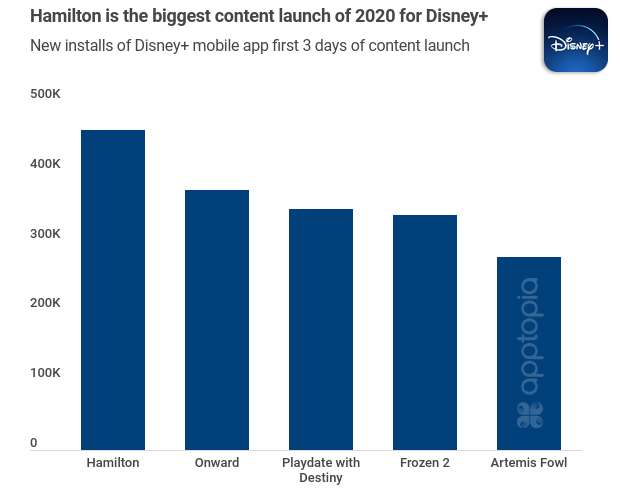
Image Credits: Apptopia
Apptopia also found that “Hamilton” represented the biggest content launch of all of 2020, so far, in terms of downloads. That means it also outpaced the streaming launch of “Frozen 2,” which arrived while consumers were under coronavirus lockdowns. It was also bigger than “Onward,” “Artemis Fowl,” and others, the firm found.

Image Credits: Disney
Of course, mobile download numbers don’t provide a full picture of how many signed up just for “Hamilton.” Many of the new Disney+ subscribers likely only signed up via a TV app and have yet to download the mobile companion.
If Roku’s online channel store offered a “top charts” section with rankings, we would have another window into Disney+ popularity given its status as a top streaming device and TV maker in the U.S. But it’s worth pointing out that Roku’s user base has given the Disney+ app a 4.3-star rating across 1,55,006 total reviews. For comparison, Netflix has 3,675,383 reviews — which shows how quickly the still relatively new service Disney+ is gaining on the market leader.
In May, Disney announced its streaming service had grown from 33.5 million subscribers as of March 28 to 54.4 million Disney+ subscribers as of May 4.
The service appeals to those who follow Disney’s top brands like Star Wars and Marvel, for example, but it’s also found a lot of growth among families who now more than ever need content to keep kids entertained amid the coronavirus outbreak, which has limited families’ usual activities and kept kids indoors. At the $6.99 per month price point (or $69.99/yr), it’s one of the more affordable streaming services available.
Updated 7/6/20 3 PM ET: Apptopia revised its estimates this afternoon to indicate a larger increase of 74%, not 72.4% as the earlier headline stated. We’ve updated the article with its most recent data as well as the firm’s latest estimates on downloads. We’ll continue to update if newer numbers arrive.
Powered by WPeMatico
Welcome back to our $100 million annual recurring revenue (ARR) series, in which we take irregular looks at companies that have reached material scale while still private. The goal of our project is simple: uncovering companies of real worth beyond how they are valued by private investors.
The Exchange is a daily look at startups and the private markets for Extra Crunch subscribers; use code EXCHANGE to get full access and take 25% off your subscription.
It’s all well and good to get a $1 billion valuation, call yourself a unicorn and march around like you invented the internet. But reaching material revenue scale means that, unlike some highly valued companies, you’re actually hard to kill. (And more valuable, and more likely to go public, we reckon.)
 Before we dive into today’s new companies, keep in mind that we’ve expanded the type of company that can make it into the $100M ARR club to include companies that reach a $100 million annual run rate pace. Why? Because we don’t only want to collect SaaS companies, and if we could go back in time we’d probably draw a different box around the companies we are tracking.
Before we dive into today’s new companies, keep in mind that we’ve expanded the type of company that can make it into the $100M ARR club to include companies that reach a $100 million annual run rate pace. Why? Because we don’t only want to collect SaaS companies, and if we could go back in time we’d probably draw a different box around the companies we are tracking.
If you need to catch up, you can find the two most recent entries in the series here and here. For everyone who’s current, today we are adding Snow Software, A Cloud Guru, Zeta Global and Upgrade to the club. Let’s go!
Just this week, Snow Software announced that it has crossed the $100 million ARR mark, according to a release shared with TechCrunch. The Swedish software asset management company has raised a few private rounds, including a $120 million private equity round in 2017. But, unlike many American companies that make this list, we don’t have a historical record of needing extensive private capital to scale.
Powered by WPeMatico
Crowdsourced navigation platform Waze, which is owned by Google and yet remains a separate, but intertwined product relative to Google Maps, just got one of its biggest UI and design overhauls ever. The new look is much more colorful, and also foregrounds the ability for individual drivers to share their current emotions with Moods, a set of user-selectable icons (with an initial group of 30) that can reflect how you’re feeling as you’re driving.
Moods may seem like a relatively small user-personalization option, but it’s actually a very interesting way for Waze to add another data vector to the crowdsourced info it can gather. In a blog post describing the feature, Waze Head of Creative Jake Shaw talks about the added Mood set, which builds upon the Moods feature previously available in Waze and greatly expands the set of expressible emotions.
“The fundamental idea of Moods has always been the same: to reflect how users feel on the road,” he wrote. “We had a lot of fun exploring the range of emotions people feel out there. A dozen drivers could all feel different in the exact same situation, so we set about capturing as many of those feelings as possible. This was critical to us, because the Moods act as a visual reminder of all of us out there, working together.”
Extending Moods to be more varied and personalized definitely has the advantage of being more visually appealing, and that could serve to boost its engagement among the Waze user community. They don’t mention this explicitly, but you can imagine that combining this as a sort of sentiment measure along with other crowd-reported navigational details, including traffic status, weather conditions, construction and more, could ultimately help Waze build a much richer data set and resulting analyses for use in road planning, transportation infrastructure management and more.
This update also includes a full refresh of all the app’s interfaces, using colored shapes based around a grid system, and new icons for reported road hazards. It’s a big, bright change, and further helps distinguish Waze’s visual identity from that of its sibling Google Maps, too.
Shaw talk repeatedly about the value of the voice of the community in informing this redesign, and it definitely seems interested in fostering further a sense of participation in that community, as distinct from other transportation and navigation apps. Oddly, this serves as a reminder that Google’s most successful social networking product, with the exception maybe of YouTube depending on how you define it, may well be Waze.
Powered by WPeMatico
The fact that Apple takes a 30% cut of subscriptions purchased via the App Store isn’t news. But since the company threatened to boot email app Hey from the platform last week unless its developers paid the customary tribute, the tech world and lawmakers are giving Apple’s revenue share a harder look.
Although Apple’s Senior Vice President of worldwide marketing Phil Schiller denied the company was making any changes, a new policy will let developers challenge the very rules by which they were rejected from the platform, which suggests that change is in the air.
According to its own numbers, the App Store facilitated more than $500 billion in e-commerce transactions in 2019. For reference, the federal government has given out about $529 billion in loans to U.S. businesses as part of the Paycheck Protection Program.
Given its massive reach, is it time for Apple to change its terms? Will it allow its revenue share to go gently into that good night, or does it have enough resources to keep new legislation at bay and mollify an increasingly vocal community of software developers? To examine these questions, four TechCrunch staffers weighed in:
Apple is starting to see that its simplistic and paternalistic approach to cultivating the app economy may be doing more harm than good. That wasn’t always the case: In earlier days it was worth paying Apple simply for the privilege of taking part in its fast-expanding marketplace.
But the digital economy has moved on from the conditions that drove growth before: Novelty at first, then a burgeoning ad market supercharged by social media. The pendulum is swinging back to more traditional modes of payment: one-time and subscription payments for no-nonsense services. Imagine that!
Combined with the emergence of mobile platforms not just as tools for simple consumption and communication but for serious work and productivity, the stakes have risen. People have started asking, what value is Apple really providing in return for the rent it seeks from anyone who wants to use its platform?
Surely Apple is due something for its troubles, but just over a quarter of a company’s revenue? What seemed merely excessive for a 99-cent app that a pair of developers were just happy to sell a few thousand copies of now seems positively extortionate.
Apple is in a position of strength and could continue shaking down the industry, but it is wary of losing partners in the effort to make its platform truly conducive to productivity. The market is larger and more complicated, with cross-platform and cross-device complications of which the App Store and iOS may only be a small part — but demanding an incredibly outsized share.
It will loosen the grip, but there’s no hurry. It would be a costly indignity to be too permissive and have its new rules be gamed and hastily revised. Allowing developers to push back on rules they don’t like gives Apple a lot to work with but no commitment. Big players will get a big voice, no doubt, and the new normal for the App Store will reflect a detente between moneyed interests, not a generous change of heart by Apple.
Powered by WPeMatico
With iOS 14, Apple is going to update Apple Maps with some important new features, such as cycling directions, electric vehicle routing and curated guides. But the app is also going to learn one neat trick.
In dense areas where you can’t get a precise location, Apple Maps will prompt you to raise your phone and scan buildings across the street to refine your location.
As you may have guessed, this feature is based on Look Around, a Google Street View-inspired feature that lets you … look around as if you were walking down the street. It’s a bit more refined than Street View as everything is in 3D so you can notice the foreground and the background.
Look Around is only available in a handful of U.S. cities for now, such as San Francisco, New York, Chicago, Washington, DC, and Las Vegas. But the company is still expanding it with Seattle coming on Monday and major Japanese cities this fall. Some areas that are only accessible on foot will also be available in the future.
When you scan the skyline to refine your location, Apple doesn’t send any data to its servers. Matching is done on your device.
When it comes to guides, Apple has partnered with AllTrails, Lonely Planet, The Infatuation, Washington Post, Louis Vuitton and others to add curated lists of places to Apple Maps. When you tap on the search bar and scroll down on the search card, you can see guides of nearby places.
When you open a guide, you can see all the places on the map or you can browse the guide itself to see those places in a list view. You can share places and save them in a user-made guide — Apple calls it a collection in the current version of Apple Maps.
You can also save a curated guide altogether if you want to check it out regularly. Places get automatically updated.
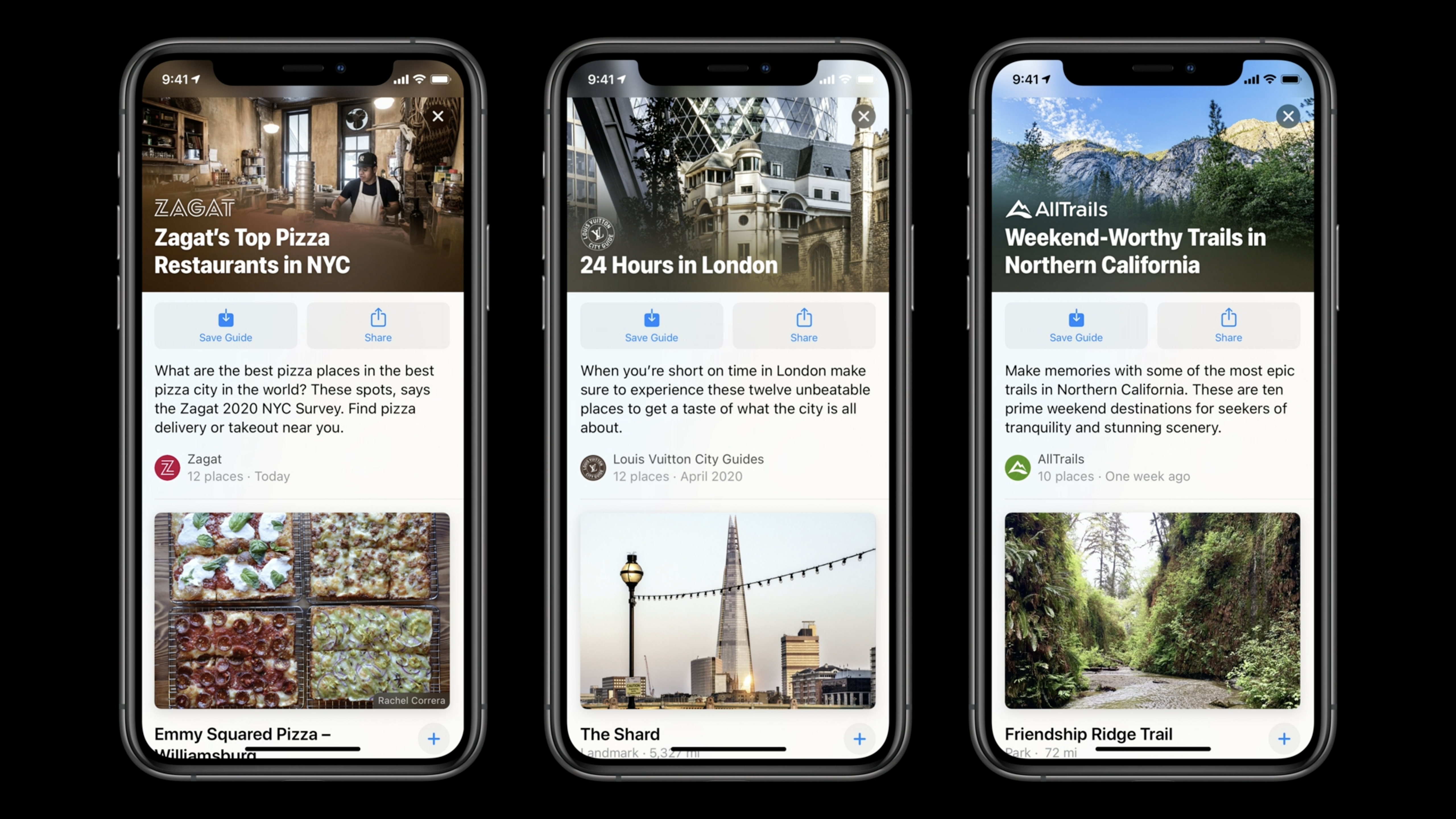
Image Credits: Apple
As for EV routing, Apple Maps will let add your car, name it and choose a charger type — Apple has partnered with BMW and Ford for now. When you’re planning a route, you can now select the car you’re going to be using. If you select your electric car, Apple Maps will add charging spots on the way. You can tap on spots to see if they are free or paid and the connector type.
Waze users will also be happy to learn that Apple Maps will be able to warn you if you’re exceeding the speed limit. You can also view speed and red light cameras on the map.
In some cities with congestion zones and license plate access, you’ll be able to add your license plate. The information is kept on the device. It’ll refine directions for those cities.
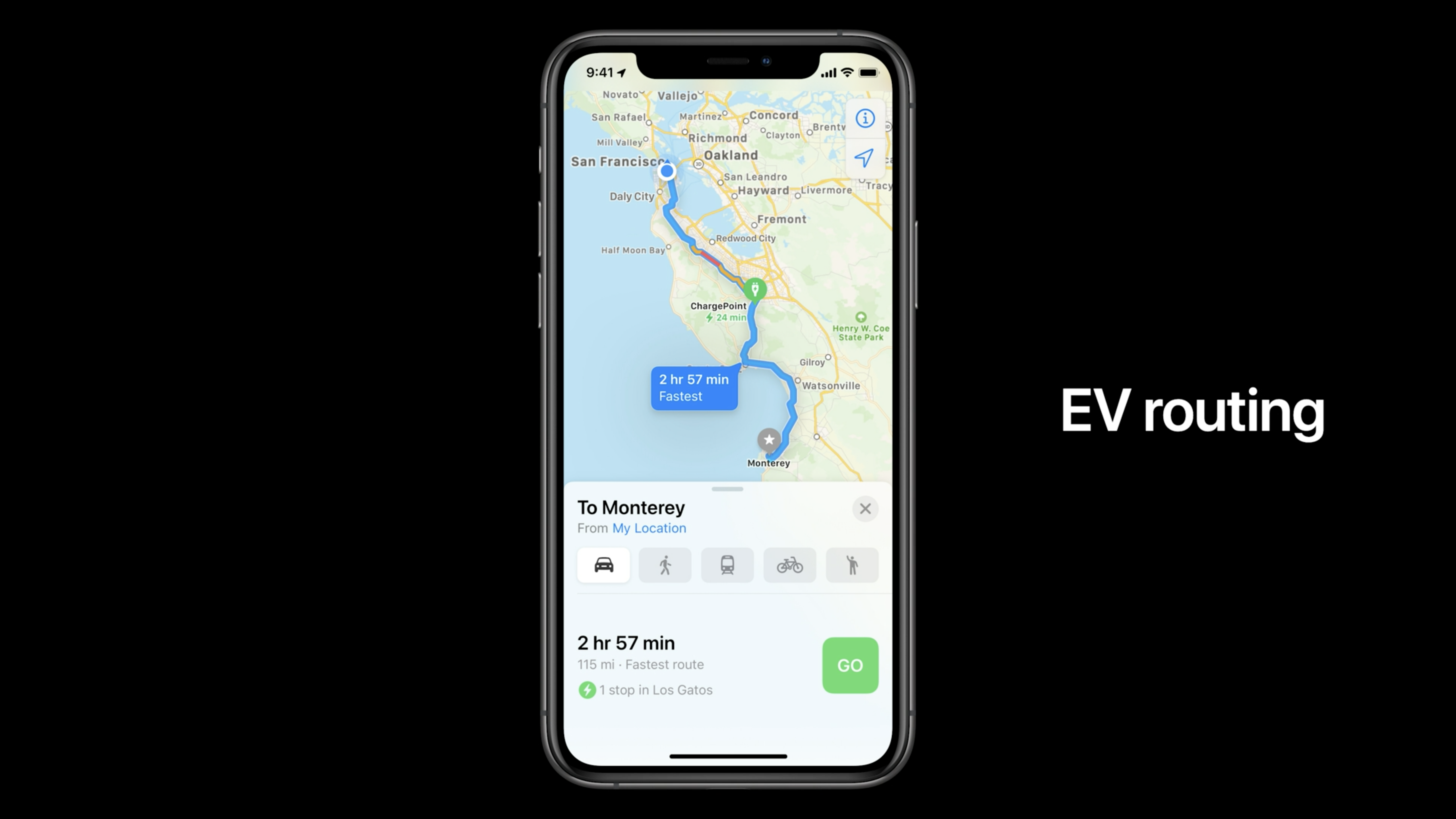
Image Credits: Apple
Finally, my favorite new feature is cycling directions. It’s only going to be available in New York City, Los Angeles, San Francisco, Shanghai and Beijing at first. Apple ticks all the right boxes, such as taking into consideration cycling paths and elevation. Turn-by-turn directions look slightly different from driving directions with a different framing and a more vertical view.
Google Maps also features cycling directions, but they suck. I can’t wait to try it out to see whether cycling directions actually make sense in Apple Maps. The new version of Apple Maps will ship with iOS 14 this fall.
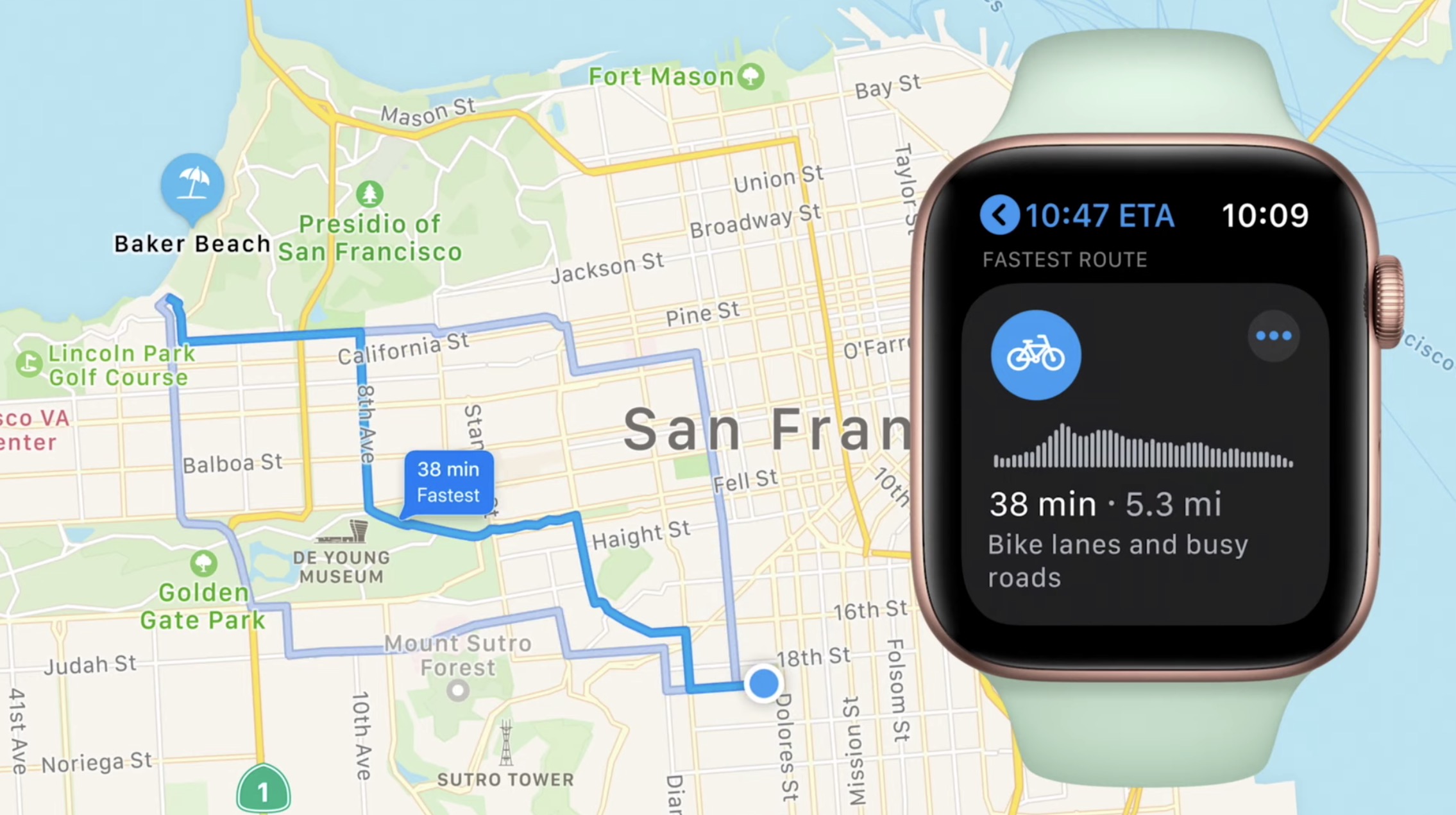
Image Credits: Apple
Powered by WPeMatico
Even before the pandemic pushed most employees to work from home, sales people often worked outside of the office. Salesforce introduced a new tool today at the Trailheadx Conference called Salesforce Anywhere that’s designed to let teams collaborate and share data wherever they happen to be.
Salesforce VP of product, Michael Machado says that the company began thinking about the themes of working from anywhere pre-COVID. “We were really thinking across the board what a mobile experience would be for the end users that’s extremely opinionated, really focuses on the jobs to be done and is optimized for what workers need and how that user experience can be transformed,” Machado explained.
As the pandemic took hold and the company saw how important collaboration was becoming in a digital context, the idea of an app like this took on a new sense of urgency. “When COVID happened, it really added fuel to the fire as we looked around the market and saw that this is a huge need with our customers going through a major transformation, and we wanted to be there to support them in Salesforce with kind of a native experience,” he said.
The idea is to move beyond the database and help surface the information that matters most to individual sales people based on their pipelines. “So we’re going to provide real time alerts so users are able to subscribe to their own alerts that they want to be notified about, whether it’s based on a list they use or a report that they work off of [in Salesforce], but also at the granularity of a single field in Salesforce,” he said.
Employees can then share information across a team, and have chats related to that information. While there are other chat tools out there, Machado says that this tool is focused on sharing Salesforce data, rather than being general purpose like Slack or any other business chat tool.
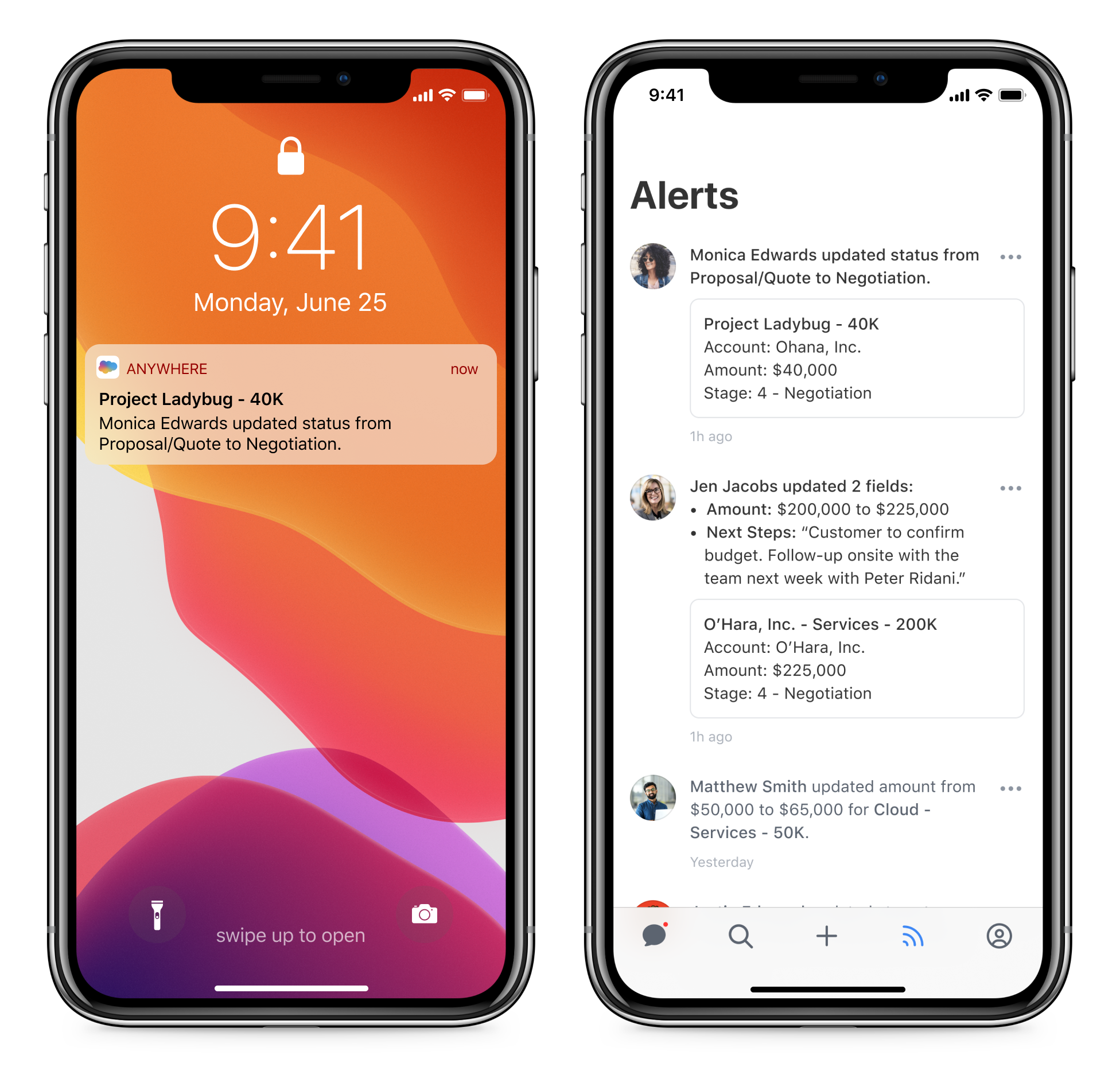
Image Credit: Salesforce
Salesforce sees this as another way to remove the complexity of working in CRM. It’s not a secret that sales people don’t love entering customer information into CRM tools, so the company is attempting to leverage that information to make it worth their while. If the tool isn’t creating a layer of work just for record keeping’s sake, but actually taking advantage of that information to give the sales person key information about their pipeline when it matters most, that makes the record keeping piece more attractive. Being able to share and communicate around that information is another advantage.
This also creates a new collaboration layer that is increasingly essential with workers spread out and working from home. Even when we return to some semblance of normal, sales people on the road can use Anywhere to collaborate, communicate and stay on top of their tasks.
The new tool will be available in beta in July. The company expects to make it generally available some time in the fourth quarter this year.
Powered by WPeMatico
A year after its initial release, Jumbo has two important pieces of news to announce. First, the company has released a major update of its app that protects your privacy on online services. Second, the company has raised an $8 million Series A funding round.
If you’re not familiar with Jumbo, the app wants to fix what’s broken with online privacy today. Complicated terms of services combined with customer-hostile default settings have made it really hard to understand what personal information is out there. Due to recent regulatory changes, it’s now possible to change privacy settings on many services.
While it is possible, it doesn’t mean it is easy. If you’ve tried to adjust your privacy settings on Facebook or LinkedIn, you know that it’s a convoluted process with a lot of sub-menus and non-descriptive text.
Similarly, social networks have been around for more than a decade. While you were comfortable sharing photos and public messages with a small group of friends 10 years ago, you don’t necessarily want to leave this content accessible to hundreds or even thousands of “friends” today.
The result is an iPhone and Android app that puts you in charge of your privacy. It’s essentially a dashboard that lets you control your privacy on the web. You first connect the app to various online services and you can then control those services from Jumbo. Jumbo doesn’t limit itself to what you can do with APIs, as it can mimic JavaScript calls on web pages that are unaccessible to the APIs.
For instance, if you connect your Facebook account, you can remove your profile from advertising lists, delete past searches, change the visibility of posts you’re tagged in and more. On Google, you can delete your history across multiple services — web searches, Chrome history, YouTube searches, Google Map activities, location history, etc.
More fundamentally, Jumbo challenges the fact that everything should remain online forever. Conversations you had six months ago might not be relevant today, so why can’t you delete those conversations?
Jumbo lets you delete and archive old tweets, Messenger conversations and old Facebook posts. The app can regularly scan your accounts and delete everything that is older than a certain threshold — it can be a month, a year or whatever you want.
While your friends will no longer be able to see that content, Jumbo archives everything in a tab called Vault.
With today’s update, everything has been refined. The main tab has been redesigned to inform you of what Jumbo has been doing over the past week. The company now uses background notifications to perform some tasks even if you’re not launching the app every day.
The data-breach monitoring has been improved. Jumbo now uses SpyCloud to tell you exactly what has been leaked in a data breach — your phone number, your email address, your password, your address, etc.
It’s also much easier to understand the settings you can change for each service thanks to simple toggles and recommendations that you can accept or ignore.
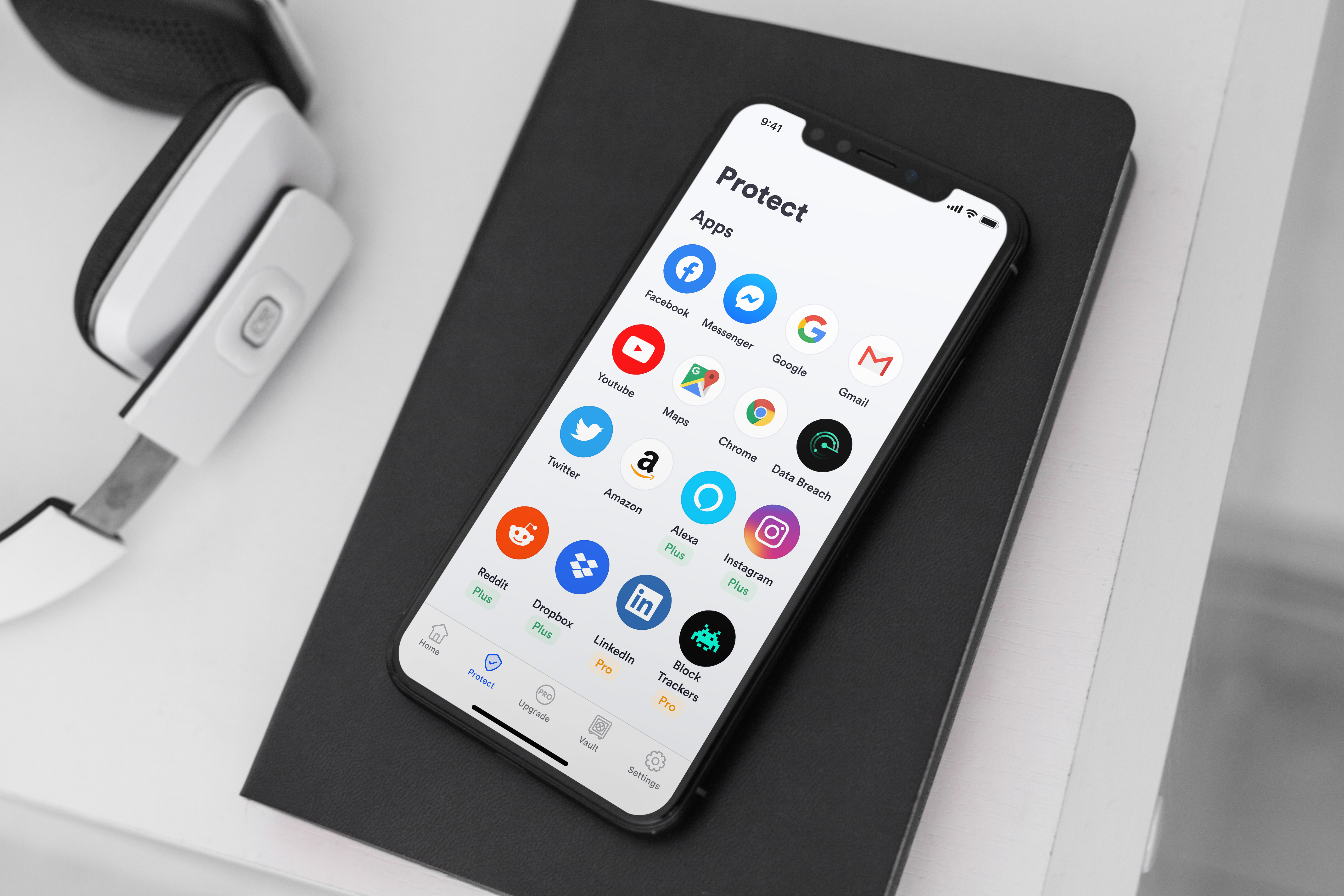
Image Credits: Jumbo
Jumbo’s basic features are free, but you’ll need to buy a subscription to access the most advanced features. Jumbo Plus lets you scan and archive your Instagram account, delete your Alexa voice recordings, manage your Reddit and Dropbox accounts and track more than one email address for data breaches.
Jumbo Pro lets you manage your LinkedIn account (and you know that LinkedIn’s privacy settings are a mess). You can also track more information as part of the data breach feature — your ID, your credit card number and your Social Security number. It also lets you activate a tracker blocker.
This new feature in the second version of Jumbo replaces default DNS settings on your phone. All DNS requests are routed through a Jumbo-managed networking profile on your phone. If you’re trying to access a tracker, the request is blocked; if you’re trying to access some legit content, the request goes through. It works in the browser and in native apps.
You can pay what you want for Jumbo Plus, from $3 per month to $8 per month. Similarly, you can pick what you want to pay for Jumbo Pro, between $9 per month and $15 per month.
You might think that you’re giving a ton of personal information to a small startup. Jumbo is well aware of that and tries to reassure its user base with radical design choices, transparency and a clear business model.
Jumbo doesn’t want to mine your data. Your archived data isn’t stored on Jumbo’s servers. It remains on your phone and optionally on your iCloud or Dropbox account as a backup.
Jumbo doesn’t even have user accounts. When you first open the app, the app assigns you a unique ID in order to send you push notifications, but that’s about it. The company has also hired companies for security audits.
“We don’t store email addresses so we don’t know why people subscribe,” Jumbo CEO Pierre Valade told me.
Jumbo has raised an $8 million funding round. It had previously raised a $3.5 million seed round. This time, Balderton Capital is leading the round. The firm had already invested in Valade’s previous startup, Sunrise.
A lot of business angels participated in the round as well, and Jumbo is listing them all on its website. This is all about being transparent again.
Interestingly, Jumbo isn’t betting on explosive growth and eyeballs. The company says it has enough funding until February 2022. By then, the startup hopes it can attract 100,000 subscribers to reach profitability.
Powered by WPeMatico
The App Store ecosystem today is home to nearly 2 million apps. That means finding new apps to download is now more challenging than ever. This, in turn, leads app developers to funnel more money into App Store Search ads, traditional SEO and digital advertising in an effort to acquire new users. A new feature called App Clips, arriving in iOS 14 later this year, will give developers another option to introduce their app to users. With App Clips, users can instead load just a small part of an app on demand, when required. And when they’re done, the App Clip disappears.
The concept behind App Clips isn’t new. Google’s Android platform has for several years offered tiny app-on-demand downloads called “Instant Apps.”
Like Instant Apps, Apple’s App Clips are about making apps as seamless to use as the web. They are fast, ephemeral and eliminate the barrier to entry that is downloading an app from the App Store.
Today, many users don’t want to bother with a full app download when they’re in a hurry. For example, if a user is trying to pay for parking, they’re more likely to swipe their credit card in the meter to save time, instead of downloading the city’s parking app.
A customer waiting in line to place a food or drink order also doesn’t want to bother downloading the restaurant’s app to browse a menu and pay — they’ll just speak their order at the counter. And a customer wanting to rent a scooter just wants to tap, pay and be on their way.
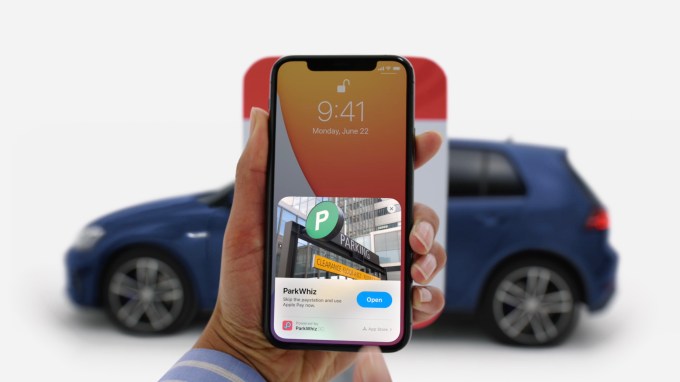
Image Credits: Apple
An App Clip would work in any of of these scenarios, and many others, by making it as easy to use apps as it is to tap to check out with Apple Pay or launch a website.
While Apple will allow users to launch clips by way of a QR code, a new “App Clip Code” arriving later this year will offer an upgraded experience to kicking off these apps you find suggested to you out in the real world. App Clip Codes will combine both NFC and a visual code, so users can either tap or scan the code to access the App Clip experience.

Image Credits: Apple
For example, an App Clip Code placed on a parking meter would allow a user to quickly load just the part of the app where they pay for their time. They can even skip manual credit card entry by using Apple Pay, if included in a given App Clip.
The App Clips themselves are less than 10 MB in size and ship bundled with the app on the App Store. They’re built using the same UI technologies developers use today to build apps, like UIKit or SwiftUI. But using an App Clip doesn’t trigger the app to download to the user’s device.
A key advantage App Clips offer is how they address concerns over data privacy. Because App Clips are essentially a way to run app code on demand, they’re restricted from tapping into iPhone’s more sensitive data — like health and fitness information, for example. Plus, the App Clip and all its data will automatically disappear if it’s not used again within some period of time.
However, if a user begins to launch a particular App Clip more regularly — perhaps one for their favorite coffee order at their local shop, for instance — the App Clip’s lifetime is extended and it can get smarter. In this example, the App Clip could cache the customer’s last order and present it as a recommendation, to speed up the ordering process. Eventually, this repeat user may decide to download the full app.
In that case, the hand-off is seamless as well — iOS will automatically migrate the authorizations for things like Camera, Microphone and Bluetooth access, which the App Clip had already requested. Select data can also be migrated.
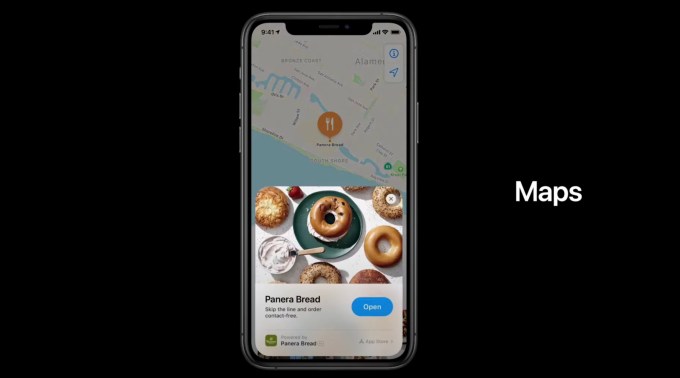
Image Credits: Apple
There are other ways for users to encounter App Clips besides out in the real world, though that may be a primary use case.
Apple says App Clips can be sent as links in iMessage, popped up as a suggestion when you’re browsing a mobile site in Safari, shown on a business’s details page in Apple Maps or may appear in Siri’s Nearby suggestions.
The idea is that wherever a user may be on their device — or out in the world — the App Clip can be there, too.
Powered by WPeMatico